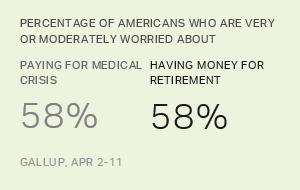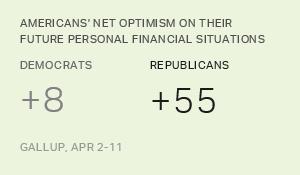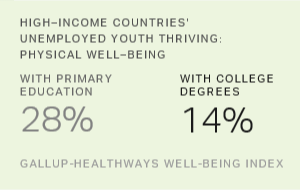Story Highlights
- Working caregivers more likely to lack money for medicine, healthcare
- Young working caregivers disproportionately suffer financial strife
- Important strategies exist for employers to help caregivers
WASHINGTON, D.C. -- Working adults in the U.S. who identify themselves as caregivers have substantially lower financial well-being than do their counterparts who are not caregivers. This deficit is particularly large for those younger than 45.
| Working caregivers | Working non-caregivers | Difference | |||||||||||||||||||||||||||||||||||||||||||||||||||||||||||||||||||||||||||||||||||||||||||||||||
|---|---|---|---|---|---|---|---|---|---|---|---|---|---|---|---|---|---|---|---|---|---|---|---|---|---|---|---|---|---|---|---|---|---|---|---|---|---|---|---|---|---|---|---|---|---|---|---|---|---|---|---|---|---|---|---|---|---|---|---|---|---|---|---|---|---|---|---|---|---|---|---|---|---|---|---|---|---|---|---|---|---|---|---|---|---|---|---|---|---|---|---|---|---|---|---|---|---|---|---|
| Total | 54.5 | 60.7 | -6.2 | ||||||||||||||||||||||||||||||||||||||||||||||||||||||||||||||||||||||||||||||||||||||||||||||||
| 18-29 | 45.3 | 58.0 | -12.7 | ||||||||||||||||||||||||||||||||||||||||||||||||||||||||||||||||||||||||||||||||||||||||||||||||
| 30-44 | 50.2 | 59.3 | -9.1 | ||||||||||||||||||||||||||||||||||||||||||||||||||||||||||||||||||||||||||||||||||||||||||||||||
| 45-59 | 57.6 | 62.5 | -4.9 | ||||||||||||||||||||||||||||||||||||||||||||||||||||||||||||||||||||||||||||||||||||||||||||||||
| 60+ | 62.8 | 67.7 | -4.9 | ||||||||||||||||||||||||||||||||||||||||||||||||||||||||||||||||||||||||||||||||||||||||||||||||
| Gallup-Sharecare Well-Being Index | |||||||||||||||||||||||||||||||||||||||||||||||||||||||||||||||||||||||||||||||||||||||||||||||||||
Across all age groups, caregivers report significantly lower financial well-being.
These results, collected as part of the Gallup-Sharecare Well-Being Index, are from surveys conducted with over 13,900 randomly selected U.S. adults who are full-time workers (defined as those working 30 hours or more per week). Of these respondents, 1,705 identified themselves as caregivers based on their response to this question: "Do you currently help care for an elderly or disabled family member, relative or friend, or not?"
An individual's financial well-being score, based on a scale from zero to 100, is derived from several questions pertaining to managing wealth and financial security. Financial well-being is one of of overall well-being.
Caregivers More Likely to Be Lower-Income, Financially Insecure
Working caregivers are more likely to be found in lower-income households than in higher-income households. For example, 9.7% of workers from households earning at least $120,000 per year identify as caregivers, compared with 14.9% of those from households earning less than $24,000 per year. As such, workers in lower-income households are 54% more likely to be caregivers than are their counterparts in higher-income households.
This income disparity seemingly manifests itself -- at least in part -- in a number of practical ways related to financial well-being. For example, healthcare insecurity is dramatically different between working caregivers and non-caregivers across age groups. Caregivers overall are nearly twice as likely to report suffering insufficient money for healthcare or medicine, mirroring the gap seen among those younger than 45.
| Working caregivers | Working non-caregivers | Difference | |||||||||||||||||||||||||||||||||||||||||||||||||||||||||||||||||||||||||||||||||||||||||||||||||
|---|---|---|---|---|---|---|---|---|---|---|---|---|---|---|---|---|---|---|---|---|---|---|---|---|---|---|---|---|---|---|---|---|---|---|---|---|---|---|---|---|---|---|---|---|---|---|---|---|---|---|---|---|---|---|---|---|---|---|---|---|---|---|---|---|---|---|---|---|---|---|---|---|---|---|---|---|---|---|---|---|---|---|---|---|---|---|---|---|---|---|---|---|---|---|---|---|---|---|---|
| % | % | (pct. pts.) | |||||||||||||||||||||||||||||||||||||||||||||||||||||||||||||||||||||||||||||||||||||||||||||||||
| Total | 21.1 | 11.3 | +9.8 | ||||||||||||||||||||||||||||||||||||||||||||||||||||||||||||||||||||||||||||||||||||||||||||||||
| 18-29 | 33.1 | 13.5 | +19.6 | ||||||||||||||||||||||||||||||||||||||||||||||||||||||||||||||||||||||||||||||||||||||||||||||||
| 30-44 | 27.5 | 12.6 | +14.9 | ||||||||||||||||||||||||||||||||||||||||||||||||||||||||||||||||||||||||||||||||||||||||||||||||
| 45-59 | 16.6 | 9.5 | +7.1 | ||||||||||||||||||||||||||||||||||||||||||||||||||||||||||||||||||||||||||||||||||||||||||||||||
| 60+ | 9.3 | 5.5 | +3.8 | ||||||||||||||||||||||||||||||||||||||||||||||||||||||||||||||||||||||||||||||||||||||||||||||||
| Gallup-Sharecare Well-Being Index | |||||||||||||||||||||||||||||||||||||||||||||||||||||||||||||||||||||||||||||||||||||||||||||||||||
Money worries, in turn, are also more prevalent among younger caregivers, particularly those under the age of 30. Among younger workers, over half of those who are serving in a caregiving role say they have worried about money in the past seven days, making them more than 40% more likely to do so than their non-caregiving counterparts.
| Working caregivers | Working non-caregivers | Difference | |||||||||||||||||||||||||||||||||||||||||||||||||||||||||||||||||||||||||||||||||||||||||||||||||
|---|---|---|---|---|---|---|---|---|---|---|---|---|---|---|---|---|---|---|---|---|---|---|---|---|---|---|---|---|---|---|---|---|---|---|---|---|---|---|---|---|---|---|---|---|---|---|---|---|---|---|---|---|---|---|---|---|---|---|---|---|---|---|---|---|---|---|---|---|---|---|---|---|---|---|---|---|---|---|---|---|---|---|---|---|---|---|---|---|---|---|---|---|---|---|---|---|---|---|---|
| % | % | (pct. pts.) | |||||||||||||||||||||||||||||||||||||||||||||||||||||||||||||||||||||||||||||||||||||||||||||||||
| Total | 37.7 | 33.2 | +4.5 | ||||||||||||||||||||||||||||||||||||||||||||||||||||||||||||||||||||||||||||||||||||||||||||||||
| 18-29 | 53.7 | 37.9 | +15.8 | ||||||||||||||||||||||||||||||||||||||||||||||||||||||||||||||||||||||||||||||||||||||||||||||||
| 30-44 | 39.6 | 34.3 | +5.3 | ||||||||||||||||||||||||||||||||||||||||||||||||||||||||||||||||||||||||||||||||||||||||||||||||
| 45-59 | 32.0 | 30.5 | +1.5 | ||||||||||||||||||||||||||||||||||||||||||||||||||||||||||||||||||||||||||||||||||||||||||||||||
| 60+ | 33.6 | 25.0 | +8.6 | ||||||||||||||||||||||||||||||||||||||||||||||||||||||||||||||||||||||||||||||||||||||||||||||||
| Gallup-Sharecare Well-Being Index | |||||||||||||||||||||||||||||||||||||||||||||||||||||||||||||||||||||||||||||||||||||||||||||||||||
Implications
That working caregivers face financial challenges may simultaneously be a direct result of their caregiving and a key reason for their being pressed into a caregiving role in the first place. While those residing in lower-income households may be more likely to take up the role of caregiving themselves due to their diminished capacity to pay for outside care, the act of caregiving and all that it entails is also likely to take a financial toll on those fulfilling this role, including out-of-pocket costs of care. These effects are disproportionately found in young adults, possibly because younger workers are less likely to have established careers, income and savings compared with their older counterparts.
For leaders of U.S. workplaces, the adverse impact of caregiving on the physical and emotional well-being of caregivers in their employ is significant, with an estimated cost in lost productivity in the tens of billions of dollars each year due to unplanned absenteeism. The financial strain suffered by these workers -- particularly those younger workers who are relatively new to the workforce -- only adds to the challenges that they face.
Past research conducted by 优蜜传媒in cooperation with ReACT identified several high-impact strategies and resources that caregivers say they would find useful -- but that are infrequently offered in workplaces. These include:
- access to financial and legal advisers specializing in caregiving
- emotional distress employee assistance programs
- assisted living and nursing home counseling
- access or direction to relevant support groups
Given the important role that caregivers play in U.S. society and its cost to the U.S. economy, these programs could have a lasting impact on the lives of these workers, the people they care for and the organizations where they work.
These data are available in .
Survey Methods
These results are based on telephone interviews conducted Jan. 2, 2015-Dec. 30, 2016, as part of the Gallup-Sharecare Well-Being Index, with a random sample of 13,914 full-time working adults, aged 18 and older, living in all 50 U.S. states and the District of Columbia. Of these, 1,705 respondents are self-identified caregivers. The sample sizes for distinct age groups are smaller.
| Total | 18-29 | 30-44 | 45-59 | 60+ | |||||||||||||||||||||||||||||||||||||||||||||||||||||||||||||||||||||||||||||||||||||||||||||||
|---|---|---|---|---|---|---|---|---|---|---|---|---|---|---|---|---|---|---|---|---|---|---|---|---|---|---|---|---|---|---|---|---|---|---|---|---|---|---|---|---|---|---|---|---|---|---|---|---|---|---|---|---|---|---|---|---|---|---|---|---|---|---|---|---|---|---|---|---|---|---|---|---|---|---|---|---|---|---|---|---|---|---|---|---|---|---|---|---|---|---|---|---|---|---|---|---|---|---|---|
| (n= ) | (n= ) | (n= ) | (n= ) | (n= ) | |||||||||||||||||||||||||||||||||||||||||||||||||||||||||||||||||||||||||||||||||||||||||||||||
| Caregiver | 1,705 | 206 | 331 | 795 | 344 | ||||||||||||||||||||||||||||||||||||||||||||||||||||||||||||||||||||||||||||||||||||||||||||||
| Non-caregiver | 12,209 | 2,341 | 3,735 | 4,182 | 1,787 | ||||||||||||||||||||||||||||||||||||||||||||||||||||||||||||||||||||||||||||||||||||||||||||||
| Gallup-Sharecare Well-Being Index | |||||||||||||||||||||||||||||||||||||||||||||||||||||||||||||||||||||||||||||||||||||||||||||||||||
For results based on the total sample of working caregivers, the margin of sampling error for the financial well-being score is ±0.9 percentage points at the 95% confidence level. This climbs to ±2.5 points for those aged 18 to 29, ±2.0 points for those aged 30 to 44, ±1.3 points for those aged 45 to 59 and ±2.0 points for those aged 60 and older. The margin of error for non-caregivers for each group is much smaller. The margin of sampling error for weekly financial worries and for food insecurity is ±2.6 percentage points at the 95% confidence level. This climbs to ±7.4 points for those aged 18 to 29, ±5.9 points for those aged 30 to 44, ±3.8 points for those aged 45 to 59 and ±5.8 points for those aged 60 and older. The margin of error for non-caregivers for each group is much smaller.
Each sample of national adults includes a minimum quota of 70% cellphone respondents/30% landline respondents in 2016 and 60% cellphone respondents/40% landline respondents in 2015, with additional minimum quotas by time zone within region. Landline and cellular telephone numbers were selected using random-digit-dial methods.
Learn more about how the works.




